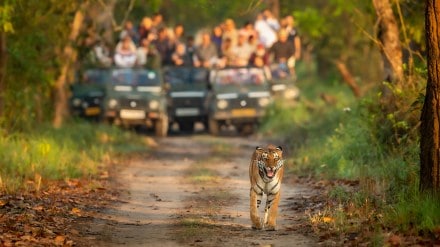With diverse landscapes, Uttar Pradesh has multiple national parks and wildlife sanctuaries teeming with exotic flora and fauna, making it a top destination for wildlife tourism in India. Here’s a guide to the leading spots that showcase the state’s remarkable biodiversity.
Dudhwa National Park
Location: Lakhimpur Kheri District, near the Nepal border
Highlights: Bengal tigers, swamp deer (Barasingha), rhinoceros, and leopards
Dudhwa National Park, part of the Dudhwa Tiger Reserve, is the crown jewel of Uttar Pradesh’s wildlife offerings. Spread across the Terai belt, the park is lush with dense sal forests, extensive grasslands, and tranquil rivers. Known for its conservation efforts, Dudhwa is one of the few places where you can spot the critically endangered swamp deer, along with an impressive tiger population. The park also has rich birdlife, making it a paradise for bird watchers.
Best Time to Visit: November to June
Katarniaghat Wildlife Sanctuary
Location: Bahraich District, along the Nepal border
Highlights: Gharial, Gangetic dolphins, leopards, and tigers
Part of the Dudhwa Tiger Reserve, Katarniaghat Wildlife Sanctuary offers an experience for those eager to explore unique habitats. The sanctuary is well-known for its rivers, wetlands, and grasslands, providing refuge to a variety of species including the endangered gharial (Indian crocodile) and the elusive Gangetic dolphins. The sanctuary is also home to diverse bird species and is a prime location for river safaris that showcase the aquatic life.
Best Time to Visit: October to March
Chambal Wildlife Sanctuary
Location: Chambal River Valley, bordering Uttar Pradesh, Madhya Pradesh, and Rajasthan
Highlights: Gharials, Indian skimmers, Gangetic dolphins, and red-crowned roof turtles
The Chambal Wildlife Sanctuary, situated on the banks of the Chambal River, is known for its stunning riverine ecosystem. It is one of the few places where the critically endangered gharial can be seen in its natural habitat. The sanctuary also shelters the Gangetic dolphin, mugger crocodiles, and several turtle species. Chambal’s birdlife, especially the rare Indian skimmer, attracts bird watchers from around the world.
Best Time to Visit: November to March
Pilibhit Tiger Reserve
Location: Pilibhit District
Highlights: Bengal tigers, leopards, wild boars, and migratory birds
One of the newer tiger reserves, Pilibhit Tiger Reserve is nestled in the Himalayan foothills along the Indo-Nepal border. The forested landscape is ideal for tiger conservation and has a healthy population of big cats. The reserve also hosts a variety of herbivores and birds, making it a perfect location for wildlife enthusiasts and photographers. Pilibhit’s diverse ecosystem, spanning grasslands, wetlands, and dense forests, offers a rare wilderness experience in the state.
Best Time to Visit: November to April
Hastinapur Wildlife Sanctuary
Location: Spread across Meerut, Ghaziabad, Bijnor, and Amroha districts
Highlights: Leopards, otters, chinkara, and an array of bird species
Hastinapur Wildlife Sanctuary, covering over 2,000 square kilometers, is one of the largest wildlife reserves in Uttar Pradesh. The sanctuary provides a unique habitat with riverine forests, open grasslands, and dense woodlands, supporting a wide variety of animals like leopards, otters, and chinkara (Indian gazelle). The sanctuary is also home to numerous migratory and resident birds, making it an attractive destination for birdwatchers.
Best Time to Visit: October to March
Saman Bird Sanctuary
Location: Mainpuri District
Highlights: Migratory birds including the Sarus crane, painted stork, and northern shoveler
Saman Bird Sanctuary is a paradise for bird watchers, especially during winter when it becomes a seasonal home for migratory birds from Siberia and Europe. The sanctuary’s wetlands attract flocks of Sarus cranes, painted storks, and northern shovelers, among others. With its serene environment and vibrant bird population, Saman offers an idyllic setting for nature photography.
Best Time to Visit: November to February
Uttar Pradesh’s wildlife reserves and sanctuaries, with their unique ecosystems and rare species, offer an exciting alternative to traditional tourism. From the majestic Bengal tigers to the graceful gharials, each sanctuary provides a different slice of wilderness that appeals to nature lovers, bird watchers, and wildlife photographers alike.
Disclaimer:
This article contains sponsored content that may not reflect the independent opinion or views of FinancialExpress.com. Further, FinancialExpress.com cannot be held responsible for the accuracy of any information presented here. Please consult a certified financial advisor before making any decisions based on this article.
